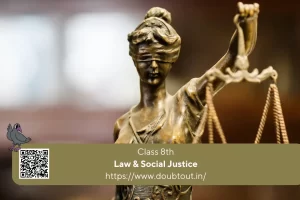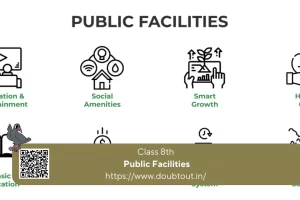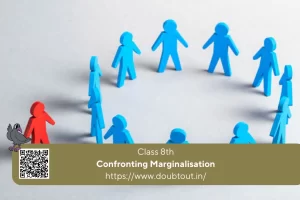
NCERT Solutions for Class 8 Civics Chapter 5 Judiciary (Updated Pattern)

In this chapter, five separate concepts of the judiciary have been explained. Students will understand the reason why the independence of the judiciary is key to its functioning. Different examples of decision-making processes have been used to explain these processes.
1. You read that one of the main functions of the judiciary is ‘upholding the law and enforcing Fundamental Rights’. Why do you think an independent judiciary is necessary to carry out this important function?
Answer An independent judiciary is necessary to carry out the function of ‘upholding the law and enforcing Fundamental Rights’. It intends to shield the judicial process from external influences and provide full legal protection to all individuals going to court for whatever reason.
Anyone can approach the courts if they believe their rights have been violated. If any law passed by the Parliament violates anyone’s Fundamental Rights, the judiciary has the power to declare such law null and void.
NCERT Solutions for Class 8 Civics Chapter 4 Understanding Laws (Updated Pattern)
2. Re-read the list of Fundamental Rights provided in Chapter 1. How do you think the Right to Constitutional Remedies connects to the idea of judicial review?
Answer The Right to Constitutional Remedies connects to the idea of judicial review in its capacity to protect the rights of an individual against the working of the State legislature or executive. It allows citizens to move the court if they think that their fundamental rights are being violated by the State administration. The judicial review implies the invalidation of legislative or executive action if it is seen to violate fundamental rights. Hence, judicial review and the Right to Constitutional Remedies are interconnected because judicial review is practised when any fundamental Right is violated by the State. In this case, a higher court can repeal the judgments of a lower court based on its own investigation.
3. In the following illustration, fill in each tier with the judgments given by the various courts in the Sudha Goel case. Check your responses with others in the class.

Answer
- Lower Court (Trial Court): Laxman, his mother Shakuntala and his brother-in-law Subhash Chandra were sentenced to death.
- High Court: Laxman, Shakuntala and Subhash Chandra were acquitted.
- Supreme Court: Laxman and Shakuntala were given life imprisonment, while Subhash Chandra was acquitted for lack of sufficient evidence.
4. Keeping the Sudha Goel case in mind, tick the sentences that are true and correct the ones that are false.
(a) The accused took the case to the High Court because they were unhappy with the decision of the Trial Court.
(b) They went to the High Court after the Supreme Court had given its decision.
(c) If they do not like the Supreme Court verdict, the accused can go back again to the Trial Court.
Answer
(a) True
(b) False. They went to the High Court after the Trial Court had given its decision.
(c) False. If they do not like the Supreme Court verdict, the accused cannot go back again to the Trial Court because the Supreme Court is the highest court in the judiciary pyramid.
Delighted Relaxation: Experience Deep Rest with Shavasana, the Corpse Pose
5. Why do you think the introduction of Public Interest Litigation (PIL) in the 1980s is a significant step in ensuring access to justice for all?
Answer The Supreme Court in the early 1980s devised a mechanism of Public Interest Litigation or PIL to increase access to justice. It allowed any individual or organisation to file a PIL in the High Court or the Supreme Court on behalf of those whose rights were violated. The legal process was greatly simplified, and even a letter or telegram addressed to the Supreme Court, or the High Court could be treated as a PIL. In the early years, PIL was used to secure justice on a large number of issues, such as rescuing bonded labourers from inhuman work conditions; one such example is securing the release of prisoners in Bihar who had been kept in jail even after their punishment term was complete.
Thus, the introduction of Public Interest Litigation is a significant step in ensuring access to justice for all.
[content-egg-block template=offers_grid]
6. Re-read excerpts from the judgment on the Olga Tellis vs Bombay Municipal Corporation case. Now, write in your own words what the judges meant when they said that the Right to Livelihood was part of the Right to Life.
Answer In the Olga Tellis vs Bombay Municipal Corporation case, the judges stated that the Right to Livelihood was part of the Right to Life. They stated that life does not merely mean an animal’s existence; it cannot be lived without a means of livelihood. In the case mentioned above, people were poor and lived in slums; they had small jobs and no other place to live. For them, eviction from their slum means deprivation of their livelihood, which consequently means deprivation of life. This is how judges connected the right to life to the basic requirements of any livelihood, i.e. Food, Clothes and shelter.
7. Write a story around the theme, ‘Justice delayed is justice denied’.
Answer Students have to do this by themselves.
8. Make sentences with each of the glossary words given on the next page.
Acquit, To appeal, Compensation, Eviction, Violation.
Answer
- Acquit: The jury decided to acquit the defendant on the grounds of lack of sufficient evidence to convict them of the crime.
- To Appeal: The defendant decided to appeal to the High Court after their lawyer said the court’s decision was not correct.
- Compensation: In compensation for the trouble caused by the flight delay, the airlines awarded the victim fifty thousand rupees.
- Eviction: The couple faced eviction because they failed to pay the monthly instalments to the bank.
- Violation: The office staff protested the company for the violation of their rights.
Tag:Civics, Class 8th, Social Science



